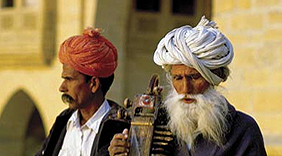
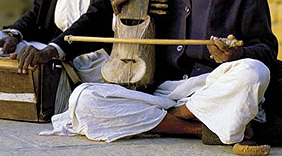

Custom Made Tour
Feel free to let us know if you are looking for customize tour program as all the tour itinerary is sample it can be modify according to your requirements.
Rajasthan Tour with Varanasi
Duration : 17 Nights / 18 DaysDestination : Delhi - Agra - Ranthambore - Jaipur - Chittaurgarh - Udiapur - Kumbalgarh - Jodhpur - Jaisalmer - Bikaner - Mandwa - Delhi

Rajasthan Tour with Varanasi Highlight
| City | Tour Highlight |
| Delhi | Red Fort, Raj Ghat, Jama Masjid, Chandni Chowk, India Gate, President's House, Humayun's Tomb & Qutub Minar Optional Sound & Light Show at Red Fort with dinner at Chor Bizarre |
| Agra | Taj Mahal, Agra Fort and Fatehpur Sikri |
| Jaipur | Elephant ride to Amber Fort Palace , City Palace, Jantar Mantar (Observatory) & Hawa Mahal (Palace of Winds) Optional Cultural evening at Chokhi Dhani |
| Jodhpur | Mehrangarh Fort & Jaswant Thada |
| Udaipur | City Palace, Sahelion Ki Bari, Lok Kala Museum & Boat Ride at Lake Pichola |
| Jaisalmer | Jaisalmer Fort , Jain Temple, Patwon Ki Haveli & Camel Safari |
| Bikaner | Junagarh Fort & Lal Garh Palace |
| Mandawa | Havelis (Mansion) of Goenka, Gori Shankar & Choudaharia with Frescoes |
| Mumbai | Gateway of India, Elephanta Caves boat cruise, Prince Wales Museum & Marine Drive Optional - Bollywood Tour |
| Khajuraho | Temple Complex - Kandariya Mahadeo, Chaunsat Yogini & others |
| Varanasi | Excursion to Sarnath, Boat Ride & Explore ghats in Ganges |
Day 01 : Arrive Mumbai
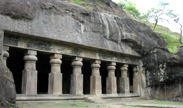
Day 02 : Mumbai - Udaipur (By Flight)
Post breakfast take City tour of Mumbai visiting Prince Wales Museum , Marine Drive which runs along the shore of the Arabian Sea from Nariman Point past Chowpatty Beach to the foot of Malabar Hill.
Starting with the Gateway of India, entrance to the port of Mumbai. It was built to commemorate the visit of King George V in 1911. Historically the Gateway holds greater significance as the last of the British troops, which left independent India by sea, followed by the Elephanta Caves boat cruise from Gateway of India. Evening transfer to airport to board flight to Udaipur. On arrival check in Hotel .
Overnight Hotel – Udaipur
Day 03 : Udaipur
 Udaipur, The City of Lakes also undoubtedly one of the most Romatic cities of India is on cards. Morning tour of Udaipur's starts with fascinating City Palace, Moulded in soft yellow stone, its windowless base is crowned with ornate turrets & canopies. Part of the Palace is now a museum with its marble & granite walls laden with brilliant miniature paintings & decorated with coloured glass & mirrors. Tour continues to the Garden of the Maids of Honour & Bhartiya Lok Kala Museum. At sunset cruise around in a boat amidst the romantic waters of Lake Pichola.Overnight Hotel – Udaipur.
Udaipur, The City of Lakes also undoubtedly one of the most Romatic cities of India is on cards. Morning tour of Udaipur's starts with fascinating City Palace, Moulded in soft yellow stone, its windowless base is crowned with ornate turrets & canopies. Part of the Palace is now a museum with its marble & granite walls laden with brilliant miniature paintings & decorated with coloured glass & mirrors. Tour continues to the Garden of the Maids of Honour & Bhartiya Lok Kala Museum. At sunset cruise around in a boat amidst the romantic waters of Lake Pichola.Overnight Hotel – Udaipur.Day 04 : Udaipur/ Jodhpur via Ranakpur (260 Kms / 06 Hrs )
Today we drive down to Jodhpur. Jodhpur, bustling desert city is the second largest city in Rajasthan & has landscape dominated by the massive Mehrangarh Fort topping a sheer rocky ridge.Rao Jodha, a chief of the Rathore clan, founded the city in the year 1459 & it is named after him. It was formerly the seat of a Princely state, also known as Marwar.
En route Ranakpur
En route we will visit Ranakpur, renowned for some marvellously carved Jain temples in marble, created in the 15th century AD during the reign of Rana Kumbha. Overnight Hotel – Jodhpur
Day 05: Jodhpur
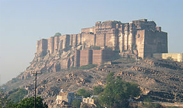
We also visit Jaswant Thada, a cluster of royal cenotaphs in white marble built in the year 1899 AD in memory of Maharaja Jaswant Singh II. Within the main cenotaph are the portraits of various Jodhpur rulers. It is an architectural landmark of Jodhpur.
Overnight Hotel – Jodhpur
Day 06 : Jodhpur /Jaisalmer
Today we drive to Jaisalmer, founded in the year 1156 by Bhatti Rajput ruler Rawal Jaisal. Often described as Golden City & rising from the heart of the Thar Desert like a golden mirage the commanding Fort etched in yellow sandstone, dominates the amber-hued city with its entire awesome splendour. Because of its strategic location it was an important ancient trading centre & camel caravans laden with precious spices & silk crossed the territory en-route India, Sindh, Arabia & Europe. The merchants of the 19th century built Havelis (Mansions) that are exquisitely carved from golden-yellow sandstone & are still in a beautiful condition. The life within the Fortified town conjures up images of medieval majesty visible in its narrow lanes strewn with magnificent palace, havelis, temples, & of course skilled artisans & ubiquitous camels. Overnight Hotel – Jaisalmer
Day 07 : Jaisalmer
Today we visit the old town of Jaisalmer & visit Jaisalmer Fort, built in the year 1156 by Rawal Jaisal. Perched on 80m high hill, housing the entire township within its ramparts, the golden hued Fort is standing like a sentinel in the bleak desert landscape. It is the only “Living Fort” in India & within its ramparts has an enchanting cow-web of narrow lanes dotted with some lovely Havelis (Mansions), Palaces & beautifully sculptured Jain Temples of the 12th-15th century AD & of course skilled artisans & ubiquitous camels.
 We also visit magnificent Patwon Ki Haveli in the heart of the town. It was built by the rich merchant Guman Chand Patwa & his sons, whose business stretched between Afghanistan & China. It is the most elaborate & magnificent of all the Jaisalmer Havelis & is virtually the showpiece of Jaisalmer's legendary architectural wealth. The carving on stone far surpasses in beauty the work on brocade & gold. Later we drive down 40 km away from Jaisalmer to Sam to take the Camel ride on the Sand Dunes of Sam while the sun is setting down.
We also visit magnificent Patwon Ki Haveli in the heart of the town. It was built by the rich merchant Guman Chand Patwa & his sons, whose business stretched between Afghanistan & China. It is the most elaborate & magnificent of all the Jaisalmer Havelis & is virtually the showpiece of Jaisalmer's legendary architectural wealth. The carving on stone far surpasses in beauty the work on brocade & gold. Later we drive down 40 km away from Jaisalmer to Sam to take the Camel ride on the Sand Dunes of Sam while the sun is setting down.Overnight Hotel – Jaisalmer
Day 08 : Jaisalmer - Bikaner (325km - 6hr)
Today we drive to the princely state of Bikaner, founded by Rao Bikaji (1465-1504 AD) in the year 1488 AD. He was a Rajput prince, descendent of the founder of neighbouring Jodhpur. It lies in the north-western part of Rajasthan & has a stark beauty of the desert landscape with wide-spread sand dunes & thorny shrubs growing around. It is a royal city surrounded by a mammoth fortification wall, more than 5 km in circumference & about 5 to 9m high. Fort, Palaces & people with colourful traditional costumes are the chief attractions of the city. The Camel Breeding Farm in Bikaner is only one of its kinds in the whole Asia & so is the illustrious Camel Festival.
Overnight Hotel – Bikaner
Day 09 : Bikaner - Mandawa (160 km - 4 hr)
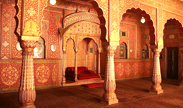
Later we drive to Mandawa in the heart of the semi-arid Shekhawati region. Shekhawati owes its name to Rao Shekha who ruled this area in the 14th century. The Fort of Mandawa was built in the year 1755 by Thakur Nawal Singh, the founder of the town. These were the times when Mandawa was settled & fortified by the rich & dominant Silk Route merchants of the region, who constructed many Havelis (Mansions), Chhatris (Cenotaphs), Temples & Baolis (Step-wells) with ornate frescoes adorning their walls & now aptly given the epithet – Open-Air Gallery. With the migration of these merchant families, their old settlements remained in total obscurity with no one to look after them. Mandawa still retains the charm & aura of a bygone era & coming here is like stepping into a different world.
Overnight Hotel – Mandawa
Day 10 : Mandawa / Jaipur ( 150Kms / 03 Hrs )
Today we explore the Mandawa Fort, located in the very heart of Mandawa & a classic example of the famed Rajput style of architecture. It houses many beautiful paintings & frescoes that dazzle the eyes & now been converted into a heritage hotel. Gulab Rai Haveli built in the year 1870 that has some of the best murals in Shekhawati on both the exterior & interior walls with elephants & camels on its façade. Goenka Double Haveli, built in the year 1890, with monumental frescoes of elephants & horses decorating its façade. Bansidhar Newatia Haveli built in the year 1921 combines traditional frescoes of horses & elephants with those depicting a young boy using a phone plus opulent touring cars & the Wright Brothers’ plane. If time permits we may visit more Havelis of the region & observe the colourful village life in Rajasthan.
 Later we drive to Jaipur, popularly known as Pink City, the flamboyant & colourful capital of Rajasthan. With its rich & colourful past, resplendent with tales of valour & bravery, it is now one of the most important heritage cities in India. The city was founded in 1728 by Maharaja Sawai Jai Singh II, the ruler of Amber. It remains the only city in the world symbolizing the nine divisions of the universe, through nine rectangular sectors. Overnight Hotel - Jaipur
Later we drive to Jaipur, popularly known as Pink City, the flamboyant & colourful capital of Rajasthan. With its rich & colourful past, resplendent with tales of valour & bravery, it is now one of the most important heritage cities in India. The city was founded in 1728 by Maharaja Sawai Jai Singh II, the ruler of Amber. It remains the only city in the world symbolizing the nine divisions of the universe, through nine rectangular sectors. Overnight Hotel - Jaipur Day 11 : Jaipur
Today we take an excursion to Amber Fort (11 km); the palace complex which stands to this date was commenced under the reign of Raja Man Singh. We take an Elephant ride to reach the Fort situated on the hill, an overwhelming experience.
Later we visit the City Palace, a perfect blend of Rajasthani & Mughal architecture. The center of the palace is a seven-storied building called Chandra Palace, with fine views over the gardens & the city. Further we visit Jantar Mantar, the Solar Observatory, an astronomical treasure house, with solar devices that give accurate predictions till date. We now visit Hawa Mahal (Palace of Winds), a five-storied structure of pink sandstone. It was built in year 1799 so that veiled royal women could peer down unseen by the world through its 593 stone Jharokas (mini windows). Overnight Hotel – Jaipur
Day 12 : Jaipur – Agra via Fatehpur Sikri (260 km - 6 hr)
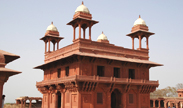
Later drive to Agra, En route visit Fatehpur Sikri, a masterpiece in sandstone with the stunning elegance of its palaces & courts. Further proceed to Agra, upon arrival check-in at our hotel Evening at leisure. Overnight Hotel – Agra
Day 13 : Agra
Agra, the erstwhile capital of India under Great Mughals & known for Taj Mahal - Eternal Poetry of love, built by emperor Shah Jahan in memory of his beloved wife Mumtaz Mahal. Most of Agra is on the West bank of river Yamuna, with the Agra Fort & the Taj Mahal at its nucleus. Taj Mahal is quite simply one of mankind's most remarkable creations. After an early breakfast, visit Taj Mahal , followed by Agra Fort. Later in the afternoon take an excursion to Sikandara , Akbar's tomb.Overnight Hotel – Agra
Day 14 : Agra / Jhansi ( by Train) Khajuraho via Orchha (166km - 05hr)
Today we take Shatabdi Express train to Jhansi. From Jhansi we drive to Khajuraho, en route we visit Orchha, located at a distance of 16 km from Jhansi. It has a medieval town atmosphere attached to it. The Betwa River quietly flows by the town. The 16th century palaces & temples built by its Bundela rulers appear to be suspended in time. We will visit Orchha Fort complex. Within the Fort complex we visit Jahangir Mahal, built by Raja Bir Singh Ju Deo in the 17th century to commemorate the visit of Emperor Jehangir to Orchha. Raj Mahal, built in the 17th century by Madhukar Shah, the deeply religious predecessor of Bir Singh Ju Deo. We also visit Ram Raja temple, palace-turned-temple with soaring spires & palatial architecture. Built by the King Madhukar Shah it is one of the most unusual temples in India & the only place where Lord Rama is worshipped as a King not as a deity.
 Later we continue our drive to Khajuraho, built between 950-1050 AD by the mighty warrior kings of the Chandela dynasty, a truly inspired burst of creativity. Contain stunningly explicit erotic sculptures. They were rediscovered in the 20th century, is now a UNESCO World Heritage Site. Overnight Hotel - Khajuraho
Later we continue our drive to Khajuraho, built between 950-1050 AD by the mighty warrior kings of the Chandela dynasty, a truly inspired burst of creativity. Contain stunningly explicit erotic sculptures. They were rediscovered in the 20th century, is now a UNESCO World Heritage Site. Overnight Hotel - Khajuraho Day 15 : Khajuraho
Today we visit Khajuraho temples, famous for the magnificent carvings depicting numerous exotic postures of the famous Kamasutra, ancient Indian work on sex. Only 22 temples survive of the 85 originally built. In fact, worship is still done today in the Matangeshwara temple, continuing an unbroken 1000 year tradition. Overnight Hotel – Khajuraho.
Day 16 : Khajuraho - Varanasi
Today we take a flight to Varanasi, picturesquely situated on the banks of holy river Ganga. The city is the Oldest Living City of the World & traces of its existence are found around 10000 BC. Other than being a very holy city for Hindus, it also holds a very significant association with Buddha's life & Buddhism. Overnight Hotel - Varanasi
Day 17 : Varanasi - Delhi ( BY flight)
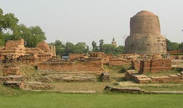
Later today we take an excursion to Sarnath, the site of the deer park where Gautama Buddha is said to have given his first sermon about the basic principles of Buddhism. It has been a premier centre for Buddhism & has a rich collection of ancient Buddhist relics & antiques comprising numerous Buddha & Bodhisattva images on display at the Archaeological Museum. Next we take the flight to Delhi, upon arrival Transfer to Airport for onward Destination. Overnight hotel - Delhi
Day 18 : Delhi
Today we take a guided tour of Old Delhi, the 17th century walled city of Shah Jehanabad, Visiting the great Jama Masjid, the principal mosque of Old Delhi. Built in the year 1656 AD by the Mughal Emperor Shah Jahan, it is the largest & best known mosque in India. Later we walk down or take a rickshaw ride through Chandi Chowk, the old marketplace of Shah Jahanabad now a picturesque bazaar to reach Red Fort, built in the year 1648 by Shah Jehan.
 In New Delhi, we visit Raj Ghat, memorial to the Father of the Nation, Mahatma Gandhi. It is a simple black marble platform that marks the spot of his cremation on 31 January 1948. Further we drive past India Gate, memorial built in the year 1931 to commemorate the Indian soldiers who died in the World War I & the Afghan Wars. The names of the soldiers who died in these wars are inscribed on the walls. President's House, the official residence of the President of India, built in 1931. Until 1950 it was known as Viceroy's House & served as the residence of the Governor-General of British India. We will also visit Humayun's Tomb, memorial of Mughal Emperor Humayun, built in the year 1562. The complex is a World Heritage Site & the first example of this type of Mughal architecture in India. Qutub Minar, built in the year 1206 by Qutub-ud-din Aybak. It is the tallest (72m) brick minaret in the world, an important example of Indo-Islamic Architecture. Qutub Minar & its monuments are listed as a UNESCO World Heritage Site.
In New Delhi, we visit Raj Ghat, memorial to the Father of the Nation, Mahatma Gandhi. It is a simple black marble platform that marks the spot of his cremation on 31 January 1948. Further we drive past India Gate, memorial built in the year 1931 to commemorate the Indian soldiers who died in the World War I & the Afghan Wars. The names of the soldiers who died in these wars are inscribed on the walls. President's House, the official residence of the President of India, built in 1931. Until 1950 it was known as Viceroy's House & served as the residence of the Governor-General of British India. We will also visit Humayun's Tomb, memorial of Mughal Emperor Humayun, built in the year 1562. The complex is a World Heritage Site & the first example of this type of Mughal architecture in India. Qutub Minar, built in the year 1206 by Qutub-ud-din Aybak. It is the tallest (72m) brick minaret in the world, an important example of Indo-Islamic Architecture. Qutub Minar & its monuments are listed as a UNESCO World Heritage Site.In time transfer to the airport to board the flight for onward journey.



